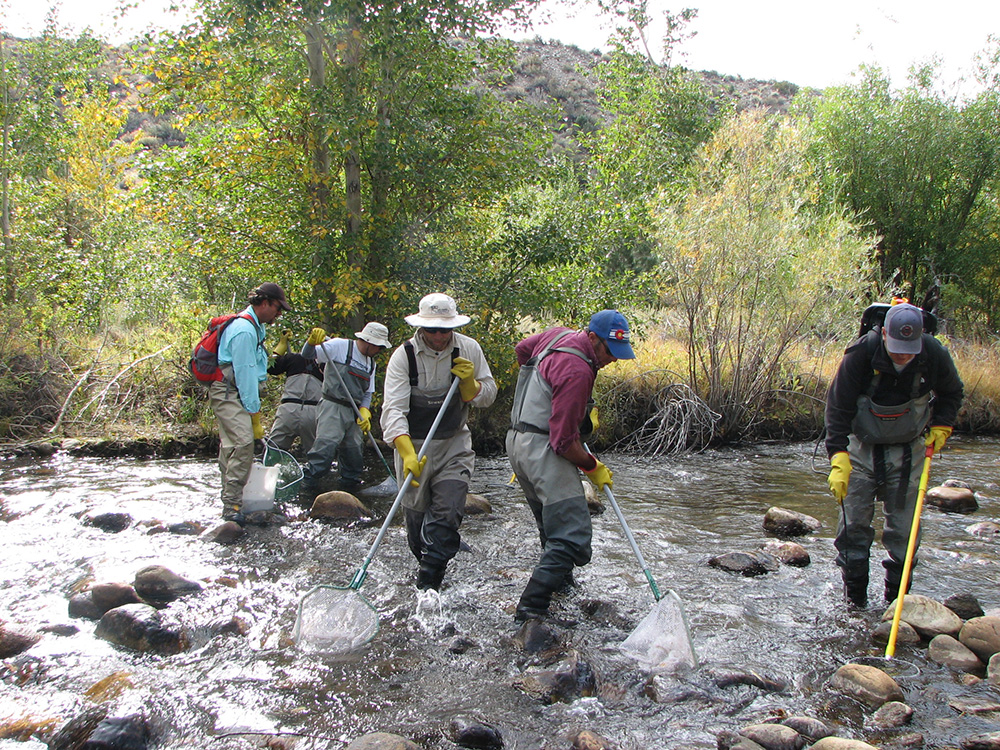
This post was written by Lisa Cutting, 2002-2020 Eastern Sierra Policy Director, 2000-2001 Environmental Resource Coordinator, and 1999 Mono Lake Intern.
A surprising thing happened this year in Lee Vining: record-breaking spring and summer precipitation which, thankfully, minimized drought-related stress on vegetation and trout in Mono Lake’s tributary streams. Instead of the brown-gray colors of drought, we saw unusually green vegetation for most of the summer—even the wildflowers were surprisingly robust. The rain was mostly
associated with thunderstorms, when twenty-degree drops in ambient air temperature weren’t unusual. This cooling effect, in the form of rain and air temperature, helped keep the creeks cool enough for trout.
But as soon as the effects of the precipitation dropped off in August, vegetation immediately responded to the extremely dry conditions—an indication that the plants had been living off surface moisture and not a healthy groundwater system.

Committee expands monitoring program
In an effort to better understand the effects of the drought, the Mono Lake Committee added bi-monthly monitoring of Grant Lake Reservoir’s water temperature and dissolved oxygen levels to the existing summer monitoring program. Committee staff collected dissolved oxygen and temperature readings at one-foot depth intervals in three separate locations—inlet, outlet, and the deepest part of the lake—throughout the summer, since conditions in Grant directly influence Rush Creek.
Data collected shows that the reservoir warmed to over 18° Celsius (65° Fahrenheit) in early July near the outlet. Over the following two weeks, the surface temperature cooled as air temperatures dropped due to local thunderstorm activity. Outlet temperature readings remained steady at 18°C (65°F) through mid-August, meaning that peak daytime creek temperatures in lower Rush Creek were likely in the low 20°s Celsius (low 70°s Fahrenheit) for much of July and August. Temperatures in this range are too warm for trout. Dissolved oxygen readings near the outlet remained at 5–8 milligrams per liter during the monitoring time period—near the low end of what trout can tolerate.
We passed the data on to State Water Board-appointed fi sheries scientist Ross Taylor for evaluation, and anticipate these results to factor into management decisions related to minimum operating levels for Grant in the future. We especially thank Doug Smith, operator of Grant Lake Marina, who took us out in his boat to the monitoring sites seven times over the summer.
Scientists track drought conditions
In late summer Dr. Bill Trush and Ross Taylor, State Water Board-appointed stream scientists, collected data and observed the effects of the four-year drought on the creeks. Trush was impressed by the health and vigor of streamside vegetation despite the drought. Taylor conducted annual trout monitoring on Rush, Lee Vining, and Walker creeks and didn’t see unanticipated detrimental effects on the fish from the drought. Population numbers were low and the health of individual fish was poor, but that was to be expected.
Another thing that has become apparent this summer is that Rush and Lee Vining creeks have been insulated from the severe late-summer low flows that natural creeks are currently experiencing in the Eastern Sierra, suggesting that the State Water Board flow requirements have perhaps protected those creeks even more so under extreme dry conditions.
Still not out of the woods
Depending on fall weather patterns, Rush Creek could see lower flows by late November. When Grant Lake Reservoir hits the minimum storage amount of 11,500 acre-feet, current requirements call for a change in operations—reducing outflow to match inflow. The Committee projects that Grant could reach 11,500 acre-feet between mid-November and December. This of course will be heavily influenced by October precipitation and whether or not a Godzilla El Niño arrives.
This post was also published as an article in the Fall 2015 Mono Lake Newsletter (page 6).
